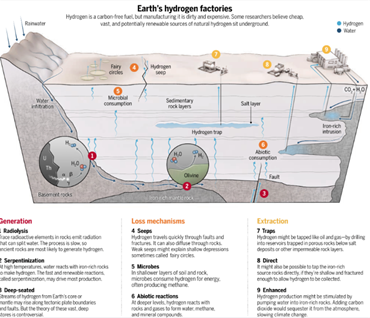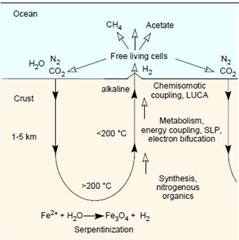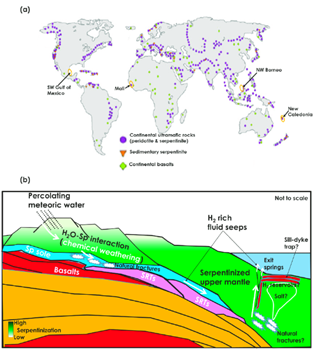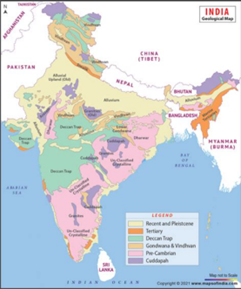THE CONTEXT: Natural hydrogen—also termed “white” or “geologic” hydrogen—is emerging as a potential game-changer in the global quest for clean energy. Unlike hydrogen produced through energy-intensive industrial processes, natural hydrogen is generated through geological phenomena such as serpentinization and radiolysis, offering a low-carbon and potentially cost-effective energy source. Recent discoveries, notably in Mali and France, have demonstrated the viability of natural hydrogen extraction, prompting a surge in global exploration efforts.
UNFCCC-aligned models show global H₂ demand could touch 500 Mt yr⁻¹ by 2050; geologic H₂ thus emerges as a potential primary energy source, not just an energy carrier.

WHERE DOES NATURAL HYDROGEN COME FROM?

| Main process | Plain-language explanation | Typical rocks |
|---|---|---|
| Serpentinisation | Rain- or groundwater seeps into iron-rich rocks. The iron “steals” oxygen from water, leaving hydrogen gas behind. | Peridotite, dunite (ultramafic rocks) |
| Radiolysis | Natural radiation in granites splits water molecules trapped in tiny cracks. | Uranium- or thorium-bearing granites |
| Organic breakdown | Heat and pressure crack old plant or plankton material deep below the surface. | Coal seams, kerogen-rich shales |
Note: Because hydrogen atoms are tiny, any open fracture or fault can let the gas move upwards and accumulate in underground “traps,” just as oil and natural gas do. Helium often co-occurs — a radiolytic fingerprint valuable for exploration.

THE GLOBAL EVIDENCE SO FAR
-
- Mali (Bourakébougou): A failed water well in 1987 was later found to vent 98 % pure hydrogen; the village now runs a mini-power plant on it.
- France (Lorraine–Moselle): Two recent finds—one in 2023, another in 2025—add up to about 92 million tonnes of hydrogen worth roughly US $ 92 billion.
- Start-ups and majors: Forty companies were exploring for natural hydrogen in 2023; U.S. start-up Koloma alone raised US $ 245 million from Amazon’s Climate Fund and Bill Gates’s Breakthrough Energy Ventures.
Cost hint: Early pilots report production costs near US $ 1 per kg—cheaper than “green” hydrogen made by electrolysis.
HOW DO GEOLOGISTS HUNT FOR IT?
1. Surface Anomaly Detection via Remote Sensing: Geologists utilize satellite imagery to identify surface features indicative of hydrogen seepage. One such feature is the presence of barren, oval-shaped depressions, often referred to as “fairy circles,” where hydrogen emissions inhibit vegetation growth. These anomalies serve as preliminary indicators of subsurface hydrogen activity.
2. Ground-Level Hydrogen Detection with Portable Sensors: Field surveys employ lightweight, portable sensors capable of detecting hydrogen concentrations mere centimeters above the ground surface. These sensors, including advanced chemiresistive and optical devices, offer high sensitivity and rapid response times, enabling the identification of subtle hydrogen emissions in various terrains.
3. Subsurface Exploration through Smart Drilling Techniques: Upon identifying promising surface indicators, geologists deploy drilling rigs equipped with real-time gas analyzers to collect core samples from subsurface formations. These smart drilling operations allow for immediate detection and analysis of hydrogen presence, ensuring accurate assessment of potential reservoirs.
4. Pilot-Scale Production Testing for Reservoir Validation: To evaluate the viability of hydrogen extraction, pilot-scale production tests are conducted on identified sites. These tests monitor the consistency and volume of hydrogen flow over extended periods, providing critical data on the reservoir’s capacity and sustainability for commercial exploitation.
WHY INDIA SHOULD TAKE NOTE
India hosts many rock types known to create or trap hydrogen:
-
- Cratons & greenstone belts: Dharwar (Karnataka), Singhbhum (Jharkhand), Bundelkhand (U.P./M.P.)
- Basalt provinces: Deccan and Rajmahal traps—millions of fractures from old lava flows.
- Ophiolite belts: Andaman–Nicobar, Ladakh-Indus suture—pieces of ancient ocean crust rich in iron minerals.
- Hot-spring zones: Ladakh, Sikkim, Maharashtra, Meghalaya hint at active water–rock reactions.
The Directorate General of Hydrocarbons (DGH) flagged “white hydrogen” as a frontier resource in its 2024 outlook

GLOBAL GOVERNANCE & POLICY LANDSCAPE
1. United States: Advancing Geologic Hydrogen Exploration
-
- USGS Geologic Hydrogen Project: The U.S. Geological Survey (USGS) is conducting extensive research on naturally occurring hydrogen, aiming to understand its generation, accumulation, and potential as an energy resource. This initiative supports the discovery and responsible management of geologic hydrogen resources.
- ARPA-E HyGeo Program: The Advanced Research Projects Agency-Energy (ARPA-E) has allocated $20 million to 16 projects under the HyGeo program. These projects focus on developing technologies for the exploration and production of geologic hydrogen, aiming to de-risk exploration and establish a foundation for commercial viability.
2. European Union: Strategic Integration of Geologic Hydrogen
-
- Critical Raw Materials Act (CRMA): Enacted in May 2024, the CRMA identifies geologic hydrogen as a strategic project, emphasizing its role in the EU’s energy transition. The Act aims to secure a sustainable supply of critical raw materials, including hydrogen, essential for green technologies.
- Strategic Projects List: The European Commission has selected 47 strategic projects to boost domestic capacities for critical raw materials, including geologic hydrogen. These projects are expected to streamline permitting processes and attract investments, reinforcing the EU’s commitment to energy security and sustainability.
INDIA’S POLICY INITIATIVES AND STRATEGIC SIGNIFICANCE
1. National Green Hydrogen Mission (NGHM)
-
- Objectives: Launched with an outlay of ₹17,490 crore, the NGHM aims to develop a green hydrogen production capacity of at least 5 million metric tonnes per annum by 2030. The mission seeks to reduce dependence on fossil fuels, promote clean energy, and position India as a global hub for green hydrogen production.
- Strategic Interventions for Green Hydrogen Transition (SIGHT): This component of NGHM provides financial incentives for the domestic manufacturing of electrolysers and the production of green hydrogen, fostering an ecosystem for sustainable energy development.
2. Geo-H₂ Frontier Program
-
- Collaborative Exploration: The Geological Survey of India (GSI) and Oil and Natural Gas Corporation (ONGC) are planning the “Geo-H₂ Frontier” program, modeled on the New Exploration Licensing Policy (NELP). This initiative aims to explore and assess India’s potential for geologic hydrogen, employing risk-sharing Production Sharing Contracts (PSCs) to attract investments and expertise.
THE ROADBLOCKS:
| Challenge | Why it matters | Possible response |
|---|---|---|
| Unknown volumes | Exploration data are sparse; success rate is still guesswork. | Launch a National Geological Hydrogen Atlas programme. |
| Regulatory vacuum | Oilfields Act (1948) never imagined hydrogen. | Draft an Energy Minerals Code that covers H₂, helium, lithium. |
| Safety | Hydrogen diffuses through metals; risk of leaks and embrittlement. | Mandate ISO-19880 standards for all wells and pipelines. |
| Social licence | Many target rocks lie under tribal or biodiversity-rich areas. | Adopt Free, Prior and Informed Consent and fair royalty sharing. |
THE WAY FORWARD:
-
- Initiate Pilot Projects in Diverse Geological Settings: Launch exploratory drilling in two distinct geological formations: an ultramafic belt (e.g., Padhar complex in Madhya Pradesh) and a basalt province (e.g., Deccan Traps in Maharashtra). These pilots will provide critical data on hydrogen presence and extraction feasibility, informing large-scale exploration strategies.
- Develop a Tailored Exploration and Production (E&P) Framework :Adapt the New Exploration Licensing Policy (NELP) model to natural hydrogen by introducing phased royalties and mandatory decommissioning bonds. This approach balances investor incentives with environmental safeguards, ensuring responsible resource development.
- Establish an Innovation Sandbox for Technological Advancements: Create a regulatory environment that encourages research and development in hydrogen extraction technologies, such as catalysts enhancing serpentinization and advanced pipeline materials to prevent hydrogen leakage. This will accelerate innovation and reduce operational risks.
- Implement Blended Finance Mechanisms: Combine sovereign green bonds with venture capital to fund initial commercial hydrogen projects. This blended finance approach mitigates investment risks and attracts private sector participation, facilitating the transition from pilot to commercial-scale operations.
- Forge International Collaborations for Knowledge Exchange: Engage with global institutions like the U.S. Geological Survey and France’s Bureau of Geology under initiatives such as Mission Innovation 2.0. These partnerships will provide access to cutting-edge research, exploration methodologies, and best practices.
- Integrate Natural Hydrogen into National Energy Policies: Amend the National Green Hydrogen Mission to include natural hydrogen exploration and production. This integration ensures cohesive policy support, aligns with India’s net-zero commitments, and positions the country as a leader in sustainable energy.
THE CONCLUSION:
Natural hydrogen could turn India’s ancient rocks into a low-carbon jackpot, but only if exploration is science-led, regulations are future-proof, and local communities share the gains.
UPSC PAST YEAR QUESTION:
Q.1 It is said the India has substantial reserves of shale oil and gas, which can feed the needs of country for quarter century. However, tapping of the resources doesn’t appear to be high on the agenda. Discuss critically the availability and issues involved. 2013
Q.2 Clean energy is the order of the day. Describe briefly India’s changing policy towards climate change in various international fora in the context of geopolitics. 2022
MAINS PRACTICE QUESTION:
Q.1 Natural hydrogen is being considered as a game-changer for the global energy transition. Analyse its feasibility and outline a policy architecture for India to leverage this resource while meeting its climate commitments.
SOURCE:
Spread the Word
